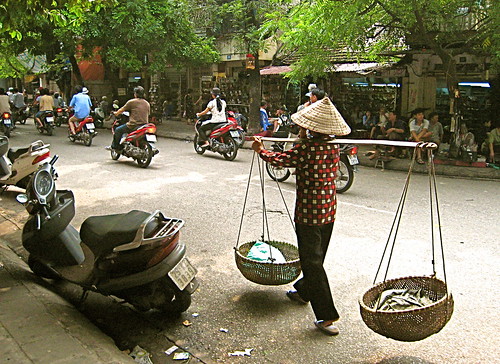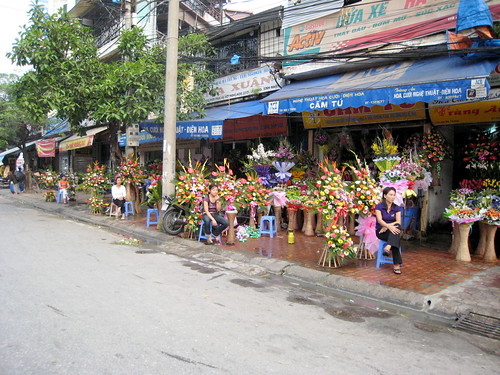Where in the world is Kim Barnes…
Hanoi, Vietnam

This is the second in a series of posts from our CEO Kim Barnes. Kim, the author of Exercising Influence: A Guide for Making Things Happen at Work, at Home, and in Your Community (Pfeiffer, 2007), has the opportunity to travel frequently to present our courses throughout the world. Hanoi is…hot, humid, bustling, noisy (the primary means of outdoor communication is the horn), dynamic, smoggy, full of contrasts, life-threatening to pedestrians. Two hours of it both fascinated me and set my teeth on edge. Bicycles, rickshaws, cars and endless streams of motorbikes jostle for space on the streets and occasionally the sidewalks, which are filled with formal and informal vendors and shops. Sidewalks along the side streets have become parking lots for motorcycles; I have to sidestep along the street in competition with the traffic. Women carrying the traditional baskets slung from a pole vie for space with tourists and young businesspeople tal king on their mobile phones. A young basket-carrier asks if i would like to take her photo, knowing that I will then feel obligated to buy her bananas. I am offered rides in taxis, on motorbikes, in rickshaws in between the informal vendors suggesting that I will want to buy whatever they are showing me – one man asks “Why not?” in perfect English when I refuse. A man from Michigan is working the tours desk of the tourist office when I stop to see what might be on offer for a day tour when I am finished with business here. He had a Vietnamese girlfriend in the States, came to visit her family and never left – except for one visit when he was stopped for driving while honking his horn, he said. It was hard to get out of the habit.
king on their mobile phones. A young basket-carrier asks if i would like to take her photo, knowing that I will then feel obligated to buy her bananas. I am offered rides in taxis, on motorbikes, in rickshaws in between the informal vendors suggesting that I will want to buy whatever they are showing me – one man asks “Why not?” in perfect English when I refuse. A man from Michigan is working the tours desk of the tourist office when I stop to see what might be on offer for a day tour when I am finished with business here. He had a Vietnamese girlfriend in the States, came to visit her family and never left – except for one visit when he was stopped for driving while honking his horn, he said. It was hard to get out of the habit.

There is evidence of the French occupation everywhere, though mostly behind the scenes. huge Gothic cathedral stands near the hotel. A hospital named after Ste. Marie sit behindA shops selling traditional crafts and fruit. The penchant for keeping one’s hair dark does not seem to have arrived here as yet, there are many grey-haired people, some bent
from years of work in the fields, I assume – they must find the squads of American tourists amusing, given their memories of the war…

This is the second in a series of posts from our CEO Kim Barnes. Kim, the author of Exercising Influence: A Guide for Making Things Happen at Work, at Home, and in Your Community (Pfeiffer, 2007), has the opportunity to travel frequently to present our courses throughout the world. Hanoi is…hot, humid, bustling, noisy (the primary means of outdoor communication is the horn), dynamic, smoggy, full of contrasts, life-threatening to pedestrians. Two hours of it both fascinated me and set my teeth on edge. Bicycles, rickshaws, cars and endless streams of motorbikes jostle for space on the streets and occasionally the sidewalks, which are filled with formal and informal vendors and shops. Sidewalks along the side streets have become parking lots for motorcycles; I have to sidestep along the street in competition with the traffic. Women carrying the traditional baskets slung from a pole vie for space with tourists and young businesspeople tal
 king on their mobile phones. A young basket-carrier asks if i would like to take her photo, knowing that I will then feel obligated to buy her bananas. I am offered rides in taxis, on motorbikes, in rickshaws in between the informal vendors suggesting that I will want to buy whatever they are showing me – one man asks “Why not?” in perfect English when I refuse. A man from Michigan is working the tours desk of the tourist office when I stop to see what might be on offer for a day tour when I am finished with business here. He had a Vietnamese girlfriend in the States, came to visit her family and never left – except for one visit when he was stopped for driving while honking his horn, he said. It was hard to get out of the habit.
king on their mobile phones. A young basket-carrier asks if i would like to take her photo, knowing that I will then feel obligated to buy her bananas. I am offered rides in taxis, on motorbikes, in rickshaws in between the informal vendors suggesting that I will want to buy whatever they are showing me – one man asks “Why not?” in perfect English when I refuse. A man from Michigan is working the tours desk of the tourist office when I stop to see what might be on offer for a day tour when I am finished with business here. He had a Vietnamese girlfriend in the States, came to visit her family and never left – except for one visit when he was stopped for driving while honking his horn, he said. It was hard to get out of the habit.
There is evidence of the French occupation everywhere, though mostly behind the scenes. huge Gothic cathedral stands near the hotel. A hospital named after Ste. Marie sit behindA shops selling traditional crafts and fruit. The penchant for keeping one’s hair dark does not seem to have arrived here as yet, there are many grey-haired people, some bent
from years of work in the fields, I assume – they must find the squads of American tourists amusing, given their memories of the war…

Greetings, welcome to Blogger. I’m glad to see you have brought your presence here Kim as I know you will have many interesting comments about your journeys and your interactions with peoples.
Thank you for providing your wisdom, your ideas and your ultimate purpose as described to the world in your actions.
Goodlife.